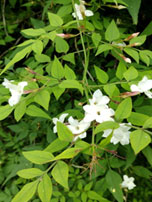Mallika

Botanical Name : Jasminum officinale
Family : Oleaceae.
Introduction :
Common jasmine is a shrubby decidious vine that is native to India and China. Its flowers are very fragrant. Common jasmine foliage is decidious. Leaves are opposite and pinnate; leaflets are ovate and pointed. Leaflets 3-7, upper surface slightly pubescent, especially on midrib and margins, lateral leaflets acute or apiculate, sessile or subsessile, the upper pair sometimes with broad connate bases, terminal much larger, ovate or lanceolate, acuminate. Flowers of common jasmine are white, and fragrant. Common jasmine is the national flower of Pakistan.
Names in different Indian languages :
English : Common Jasmine, True jasmine, Poet’s jasmine
Hindi : Chameli
Marathi : Jati-jai
Konkani : Sanjui
Sanskrit : Mallika
Habitats :
Shrubberies and forests, usually on humus-rich soils, 1200 – 3000 metres in the Himalayas[51, 145]. Valleys, ravines, thickets, woods, along rivers, meadows; 1800 – 4000 metres in W. China
Morphology :
.
Chemical constituents :
It has alkaloids, coumarins, flavonoids, tannins, terpenoids, glycosides, emodine, leucoanthcyanins, steroids, anthocyanins, phlobatinins, essential oil and saponins.
Uses : Traditionally jasmine has been used in the treatment of snakebites and as an antiseptic, as well as for the treatment of fevers, respiratory diseases, ringworm, intestinal problems and headaches. Jasmine oil is also used in aromatherapy.